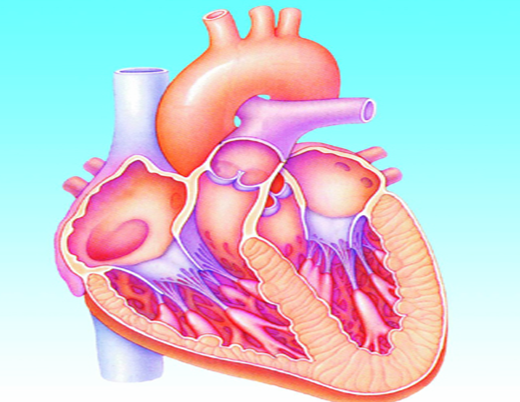Now let me draw a little line here just to keep it straight.
我画线把两部分分开
The small artery and the arteriole, these two,
而这边的小动脉和微动脉
these are actually sometimes called the muscular arteries.
则是叫做弹性动脉
Muscular arteries, and the reason, again,
为什么叫它们弹性动脉呢?
if you just want to look at the wall of the artery, you'll get the answer.
如果大家想一下血管壁的话就很容易理解了
The wall of the artery is actually very muscular.
血管壁中是富含肌肉的
In fact, specifically, it's smooth muscle.
确切的说,是有很多平滑肌
So not that kind of muscle you have in your heart or in your bicep, but this is smooth muscle
这跟心脏或者二头肌的肌肉不同,这里是平滑肌
that's in the wall of the artery, and there's lots of it.
血管壁中存在大量平滑肌
So again, if you have a little blood vessel like this,
如果有这样的一条小血管
if you imagine tons and tons of smooth muscle on the outside, so let's draw it like this.
血管壁中存在大量平滑肌,我们画一下
Little bands of smooth muscle.
有很多平滑肌
If those bands decide that they want to contract down, if they want to squeeze down,
如果这些肌肉要收缩,血管要发生挤压
you're going to get something that looks like a little straw because those muscles are now tight.
现在血管就有点像一条吸管,因为现在肌肉都是紧张的
They are tightly wound, right?
都是收缩紧绷的
So you're going to create like a little straw, and this process is called vasoconstriction.
这样就有点像一根吸管,这个过程就叫做血管收缩
Vaso- just means blood vessel, and constriction is, kinda, tightening down.
词首vaso意思是“血管”,constriction意思是“收缩”
So vasoconstriction, tightening down of the blood vessel,
这个词意思就是血管收缩
and what that does is it increases resistance, right?
血管收缩就会增加血流阻力
Just like if you're trying to blow through a tiny, tiny little straw, there's a lot of resistance.
比方说,如果向很细的吸管吹气,阻力是很大的

Well, it's the same idea here, and actually a lot of that resistance and change in the constriction,
这里也是一样,血流阻力非常大
or vasoconstriction, is happening at the arteriole level.
在小动脉的层面,影响血管收缩
So that's why they're very special, and I want you to remember them.
这是它们特殊的地方,大家要记住
From there, blood is going to go through the capillaries.
然后血液进入毛细血管
I didn't actually label them the first time, but let me just write that here.
上次我没有标记毛细血管,我写在这
Sometimes, they call them capillary beds.
有时这里也叫毛细血管床(网)
I'll write that out,
我写一下
and then it's going to go and get collected in the venules and eventually into the veins,
再往后,就到了小静脉,静脉
and the important thing about the veins,
关于静脉还有一点需要注意
I'm going to stop right here and just talk about it very briefly, is that they have these little valves,
我们在这里停一下,一起来看一下,这里有一些瓣膜
and these valves make sure that the blood continues to flow in one direction.
瓣膜存在的目的是确保血液流动的方向正确
So one important thing here is the valves,
关于瓣膜有些要点
and remember the other important thing is that they are able to deal with large volumes.
一是应对大血量的情况,二就是确保流动方向正确
So unlike the arteriole side, where it's all about large pressure,
这里并不像高压的小动脉
down here with the vein side, we have to think about large volumes.
静脉这里要考虑的,是大血量
Remember, about two-thirds of your blood at any point in time is sitting in some vein or venule somewhere.
大家记住,在任何时间身体中大约2/3的血液是在静脉和小静脉中的



